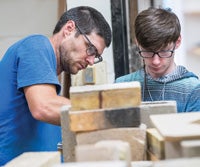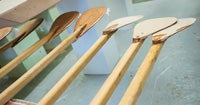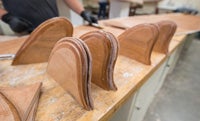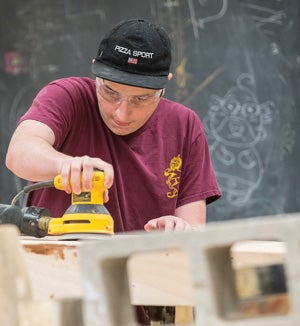Art and design students make stand-up paddleboards




From top, instructor Judd Snapp assists a student; Amber Delgado works on her board; paddles being assembled; board parts await installation.

a student sands his board
Twelve ECU students learned the art of making paddleboards during an intense summer class. Following a successful canoe-building course last summer, the School of Art and Design gave students the opportunity to make stand-up paddleboards this year.
The popularity of stand-up paddleboarding made it a good choice, said ECU instructor Judson Snapp, who has built several boards and is a former kayak guide on the Outer Banks. “It gives the students incentive to have their own when it’s done,” Snapp said.
Amber Delgado, a rising senior from Fayetteville who is majoring in art with a concentration in film and video production, took the course to fulfill a survey class requirement. “I feel a lot more comfortable working with power tools now, so that’s good,” she said, while sanding the bottom of her board. “It is a lot of work, though. It’s like a PE and a woodshop class (combined).” Delgado had never been paddleboarding before taking the class. “I’ll definitely use it after putting in all this work,” she said.
ECU junior Nick Leach has been woodworking since high school. He said growing up in Minnesota, which has more than 10,000 lakes and borders Lake Superior, means being around water. Leach also had an interest in the class as an ECU Campus Recreation Adventure employee.
“I’ve gotten to expand my knowledge,” said Leach, who has framed houses and made cabinets, furniture, cutting boards and trinket boxes. “We’re making everything from the paddle to the fins.”
The class met for four hours, four days each week during summer session 1, taking up three rooms in Jenkins Fine Arts Center. The School of Art and Design offers this type of course during the summer due to the size, scope and intense amount of work necessary to complete the projects, said director Kate Bukoski.
“These courses enhance the school’s approach of thinking through making,” Bukoski said. “The focus on functionality pushes students to consider how their evolving artistic skills can be leveraged in a different context, providing experience that enhances their professional development.”
